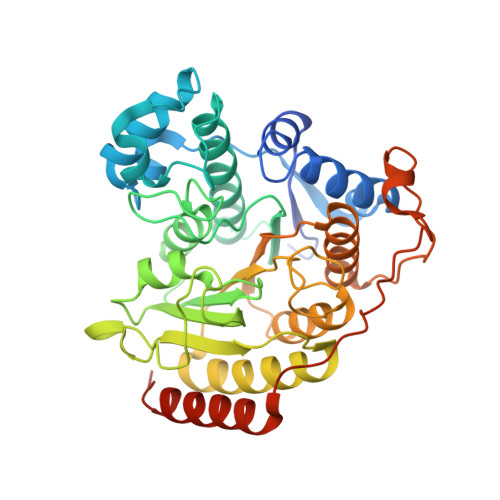Compromised Structure and Function of HDAC8 Mutants Identified in Cornelia de Lange Syndrome Spectrum Disorders.
Decroos, C., Bowman, C.M., Moser, J.A., Christianson, K.E., Deardorff, M.A., Christianson, D.W.(2014) ACS Chem Biol 9: 2157-2164
- PubMed: 25075551
- DOI: https://doi.org/10.1021/cb5003762
- Primary Citation of Related Structures:
4QA0, 4QA1, 4QA2, 4QA3, 4QA4, 4QA5, 4QA6, 4QA7 - PubMed Abstract:
Cornelia de Lange Syndrome (CdLS) is a multiple congenital anomaly disorder resulting from mutations in genes that encode the core components of the cohesin complex, SMC1A, SMC3, and RAD21, or two of its regulatory proteins, NIPBL and HDAC8. HDAC8 is the human SMC3 lysine deacetylase required for cohesin recycling in the cell cycle. To date, 16 different missense mutations in HDAC8 have recently been identified in children diagnosed with CdLS. To understand the molecular effects of these mutations in causing CdLS and overlapping phenotypes, we have fully characterized the structure and function of five HDAC8 mutants: C153F, A188T, I243N, T311M, and H334R. X-ray crystal structures reveal that each mutation causes local structural changes that compromise catalysis and/or thermostability. For example, the C153F mutation triggers conformational changes that block acetate product release channels, resulting in only 2% residual catalytic activity. In contrast, the H334R mutation causes structural changes in a polypeptide loop distant from the active site and results in 91% residual activity, but the thermostability of this mutant is significantly compromised. Strikingly, the catalytic activity of these mutants can be partially or fully rescued in vitro by the HDAC8 activator N-(phenylcarbamothioyl)benzamide. These results suggest that HDAC8 activators might be useful leads in the search for new therapeutic strategies in managing CdLS.
Organizational Affiliation:
Roy and Diana Vagelos Laboratories, Department of Chemistry, University of Pennsylvania , Philadelphia, Pennsylvania 19104-6323 United States.


















